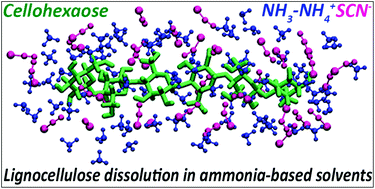Here, we report a novel ammonia : ammonium salt solvent based pretreatment process that can rapidly dissolve crystalline cellulose into solution and eventually produce highly amorphous cellulose under near-ambient conditions. Pre-activating the cellulose I allomorph to its ammonia–cellulose swollen complex (or cellulose III allomorph) at ambient temperatures facilitated rapid dissolution of the pre-activated cellulose in the ammonia-salt solvent (i.e., ammonium thiocyanate salt dissolved in liquid ammonia) at ambient pressures. For the first time in reported literature, we used time-resolved in situ neutron scattering methods to characterize the cellulose polymorphs structural modification and understand the mechanism of crystalline cellulose dissolution into a ‘molecular’ solution in real-time using ammonia-salt solvents. We also used molecular dynamics simulations to provide insight into solvent interactions that non-covalently disrupted the cellulose hydrogen-bonding network and understand how such solvents are able to rapidly and fully dissolve pre-activated cellulose III. Importantly, the regenerated amorphous cellulose recovered after pretreatment was shown to require nearly ∼50-fold lesser cellulolytic enzyme usage compared to native crystalline cellulose I allomorph for achieving near-complete hydrolytic conversion into soluble sugars. Lastly, we provide proof-of-concept results to further showcase how such ammonia-salt solvents can pretreat and fractionate lignocellulosic biomass like corn stover under ambient processing conditions, while selectively co-extracting ∼80–85% of total lignin, to produce a highly digestible polysaccharide-enriched feedstock for biorefinery applications. Unlike conventional ammonia-based pretreatment processes (e.g., Ammonia Fiber Expansion or Extractive Ammonia pretreatments), the proposed ammonia-salt process can operate at near-ambient conditions to greatly reduce the pressure/temperature severity necessary for conducting effective ammonia-based pretreatments on lignocellulose.

